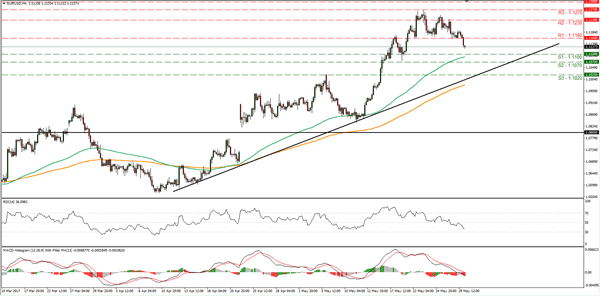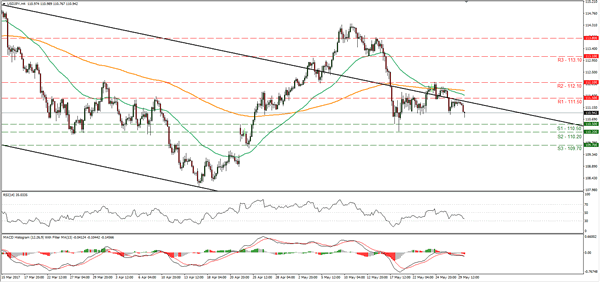The common European currency took a hit during the Asian morning Tuesday. Even though there was no clear catalyst behind this move, market chatter attributes it primarily to a media report released overnight suggesting that Greece may opt out of its next bailout payment, if it is unable to strike a debt relief deal with its creditors. We have to note though, that only one German newspaper reported this story. As such, unless we see more related reports, we doubt that market focus will remain on this issue for very long.
Instead, we think that today, investors will likely shift their attention to Germany’s CPI data for May (see below), amid heightened speculation the ECB is set to appear slightly more optimistic soon. In this respect, Draghi’s remarks yesterday did not reveal much. He mostly stuck to his script, reiterating that even though the bloc’s economy is improving, underlying inflationary pressures remain subdued and thus, substantial monetary stimulus is still necessary.
Interestingly enough though, he repeated that at the June meeting, policymakers will have updated economic forecasts and will be able to make their judgement on the distribution of risks surrounding growth and inflation. In our view, this suggests a small change in language may indeed be on the cards soon. The ECB could signal that the risks surrounding the outlook for growth are no longer tilted to the downside, and instead echo the recent view of ‘some members’ in the April minutes that the risks are ‘broadly balanced’.
Today’s highlights:
During the European day, Germany’s preliminary CPI figures for May will be in focus. The forecast is for the nation’s inflation rate to have declined notably. We see the risks surrounding that forecast as skewed to the upside, perhaps for a smaller-than-anticipated decline, considering that the preliminary Markit composite PMI for the month showed that German businesses raised their prices at one of the steepest rates in six years. Should Germany’s CPI rate surprise to the upside, it could raise some speculation for a positive surprise in the bloc’s print that is due to be released the following day and thereby, bring EUR under renewed buying interest.
EUR/USD tumbled overnight, falling below the support (now turned into resistance barrier) of 1.1160 (R1). During the early European morning Tuesday, the price looks to be headed for a test near the support zone of 1.1100 (S1). We think that the pair could stay near that key level and wait for Germany’s CPI. If indeed we see a positive surprise, the rate could rebound and test the 1.1160 (R1) barrier, where a clear break could set the stage for further upside recovery towards 1.1230 (R2). On the other hand, if the nation’s CPI rate declines in line with the consensus, the latest pullback could continue. A decisive break below 1.1100 (S1) could initially aim for 1.1070 (S2).
From Sweden, we get GDP data for Q1. The forecast is for GDP growth to have slowed somewhat in quarterly terms, but to have accelerated in yearly terms. We also get retail sales for April from both Sweden and Norway.
From the US, we get personal income and spending data, all for April. The forecast is for both the income and the spending rates to have risen from the previous month. We also get the core PCE price index for April, though no forecast is available for the yearly figure. The monthly figure is anticipated to rise 0.1% mom, which would drag the yearly rate down to +1.4% yoy from +1.6% yoy. In case of strong personal income and spending data but a soft PCE print, we are likely to see a choppy reaction in USD. We think that in order for the currency to assume a clear direction afterwards, we would need to see a notable surprise in at least one of these figures.
USD/JPY traded lower yesterday, after it hit resistance near the 111.50 (R1) barrier. In case US data are strong today, the pair could recover some of its latest losses and rebound to test the 111.50 (R1) level again. On the other hand, overall disappointing data could generate some doubts as to whether a Fed June rate hike is indeed as likely as market pricing currently suggests (84%) and thereby lead to further downside in this pair. An initial break below 110.50 (S1) could see scope for declines towards the next support at 110.20 (S2).
We have three speakers on the agenda: ECB Executive Board members Ewald Nowotny and Erkki Likanen, as well as Fed Board Governor Lael Brainard. We think market focus may be primarily on Brainard, as she will be speaking about monetary policy, a topic she did not spend too much time on during her recent appearances. Considering that she will be speaking after the core PCE print is out, her view on inflation may be of particular interest to investors ahead of the June policy meeting.
EUR/USD

Support: 1.1100 (S1), 1.1070 (S2), 1.1020 (S3)
Resistance: 1.1160 (R1), 1.1230 (R2), 1.1270 (R3)
USD/JPY

Support: 110.50 (S1), 110.20 (S2), 109.70 (S3)
Resistance: 111.50 (R1), 112.10 (R2), 113.10 (R3)













